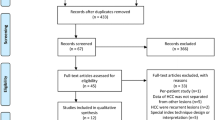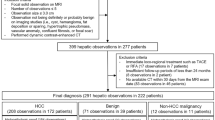Abstract
The aim of this study was to assess the added diagnostic value of contrast-enhanced US (CEUS) combined with 64-row multidetector CT (CT) in the assessment of hepatocellular nodule vascularity in patients with liver cirrhosis. One hundred and six cirrhotic patients (68 male, 38 female; mean age ± SD, 70 ± 7 years) with 121 biopsy-proven hepatocellular nodules (72 hepatocellular carcinomas, 10 dysplastic and 15 regenerative nodules, 12 hemangiomas, and 12 other benignancies) detected during US surveillance were prospectively recruited. Each nodule was scanned by CEUS during the arterial (10–40 s), portal venous (45–90 s), and delayed sinusoidal phase (from 100 s after microbubble injection to microbubble disappearance). Nodule vascularity at CEUS, CT, and combined CEUS/CT was evaluated side-by-side by two independent blinded readers who classified nodules as benign or malignant according to reference diagnostic criteria. The combined assessment of CEUS/CT provided higher sensitivity (97%, both readers) than did separate assessment of CEUS (88% reader 1; 87% reader 2) and CT (74% reader 1; 71% reader 2; P < 0.05), while no change in specificity was provided by combined analysis. The combined assessment of hepatocellular nodule vascularity at CT and CEUS improved sensitivity in the diagnosis of malignancy in patients with liver cirrhosis.







Similar content being viewed by others
References
International Working Party (1995) Terminology of nodular hepatocellular lesions. Hepatology 22:983–993
Bruix J, Sherman M, Llovet JM et al (2001) Clinical management of hepatocellular carcinoma. Conclusions of the Barcelona-2000 EASL conference. European Association for the Study of the Liver. J Hepatol 35:421–430
Bruix J, Sherman M (2005) Management of hepatocellular carcinoma. Hepatology 42:1208–1236
Iannacone R, Laghi A, Catalano C et al (2004) Focal liver lesions in the cirrhotic patient: multislice spiral CT evaluation. Radiol Med 107:304–316
Laghi A, Iannacone R, Rossi P et al (2003) Hepatocellular carcinoma: detection with triple-phase multi-detector row helical CT in patients with chronic hepatitis. Radiology 226:543–549
Ichikawa T, Kakajima H, Nanbu A, Hori M, Araki T (2006) Effect of injection rate of contrast material on CT of hepatocellular carcinoma. AJR Am J Roentgenol 186:1413–1418
Monzawa S, Ichikawa T, Nakajima H, Kitanaka Y, Omata K, Araki T (2007) Dynamic CT for detecting small hepatocellular carcinoma: usefulness of delayed phase imaging. AJR Am J Roentgenol 188:147–153
Claudon M, Cosgrove D, Albrecht T et al (2008) Guidelines and good clinical practice recommendations for contrast enhanced ultrasound (CEUS)–Update 2008. Ultraschall Med 29:28–44
Quaia E, Calliada F, Bertolotto M, Rossi S, Garioni L, Rosa L, Pozzi-Mucelli R (2004) Characterization of focal liver lesions by contrast-specific US modes and a sulfur hexafluoride-filled microbubble contrast agent: diagnostic performance and confidence. Radiology 232:420–430
Nicolau C, Catalá V, Vilana R, Gilabert R, Bianchi L, Sole M, Pages M, Bru C (2004) Evaluation of hepatocellular carcinoma using SonoVue, a second generation ultrasound contrast agent: correlation with cellular differentiation. Eur Radiol 14:1092–1099
Giorgio A, Ferraioli G, Tarantino L et al (2004) Contrast-enhanced sonographic appearance of hepatocellular carcinoma in patients with cirrhosis: Comparison with contrast-enhanced CT appearance. AJR Am J Roentgenol 183:1319–1326
Quaia E, D’Onofrio M, Cabassa P et al (2007) Diagnostic value of hepatocellular nodule vascularity after sulfur hexafluoride-filled microbubble injection in patients with liver cirrhosis: analysis of diagnostic performance and confidence in malignancy characterization. AJR Am J Roentgenology 189:1474–1483
Gaiani S, Celli N, Piscaglia F et al (2004) Usefulness of contrast-enhanced perfusional sonography in the assessment of hepatocellular carcinoma hypervascular at spiral computed tomography. J Hepatol 41:421–426
Bolondi L, Gaiani S, Celli N et al (2005) Characterization of hepatocellular nodules in 40 cirrhosis by assessment of vascularity: the problem of hypovascular hepatocellular carcinoma. Hepatology 42:27–34
Pompili M, Riccardi L, Semeraro S et al (2008) Contrast-enhanced ultrasound assessment of arterial vascularization of small nodules arising in the cirrhotic liver. Dig Liver Dis 40(3):206–215
Burns P, Wilson SR (2007) Focal liver lesions: enhancement patterns on contrast-enhanced images – Concordance of US scans with CT scans and MR images. Radiology 242(1):162–174
Forner A, Villana R, Ayuso C et al (2008) Diagnosis of hepatic nodules 20 mm or smaller in cirrhosis: prospective validation of the noninvasive diagnostic criteria for hepatocellular carcinoma. Hepatology 47:97–104
Bismuth H (1982) Surgical anatomy and anatomical surgery of the liver. World J Surg 6:3–8
Couinaud C (1957) Le foie: études anatomiques et chirurgicales. Masson, Paris, pp 9–12
Sultana S, Awai K, Nakayama Y et al (2007) Hypervascular hepatocellular carcinomas: bolus tracking with a 40-detector CT scanner to time arterial phase imaging. Radiology 243:140–147
Beck JR, Shultz EK (1986) The use of relative operating characteristic (ROC) curves in test performance evaluation. Arch Pathol Lab Med 110:13–20
Hanley JA, McNeil BJ (1983) A method of comparing the areas under receiver operating characteristic curves derived from the same cases. Radiology 148:839–843
Tanaka S, Ioka T, Oshikawa O, Hamada Y, Yoshioka F (2001) Dynamic sonography of hepatic tumours. AJR Am J Roentgenol 177:799–805
Lee HM, Lu DS, Krasny RM, Busuttil R, Kadell B, Lucas J (1997) Hepatic lesion characterization in cirrhosis: significance of arterial hypervascularity on dual-phase helical CT. AJR Am J Roentgenol 169:125–130
Baron RL, Peterson MS (2001) Screening the cirrhotic liver for hepatocellular carcinoma with CT and MR imaging: opportunities and pitfalls. Radiographics 21:S117–S132
Lim JH, Kim CK, Lee WJ et al (2000) Detection of hepatocellular carcinomas and dysplastic nodules in cirrhotic livers: accuracy of helical CT in transplant patients. AJR Am J Roentgenol 175:693–698
Rode A, Bancel B, Douek P et al (2001) Small nodule detection in cirrhotic livers: evaluation with US, spiral CT, and MRI and correlation with pathologic examination of explanted liver. J Comput Assist Tomogr 25(3):327–336
Valls C, Cos M, Figueras J et al (2004) Pretransplantation diagnosis and staging of hepatocellular carcinoma in patients with cirrhosis: value of dual phase helical CT. AJR Am J Roentgenol 182:1011–1017
Forner A, Vilana R, Ayuso C et al (2007) Diagnosis of hepatic nodules 20 mm or smaller in cirrhosis: prospective validation of the noninvasive diagnostic criteria for hepatocellular carcinoma. Hepatology 47:1–7
Krinsky GA, Lee VS, Theise ND et al (2001) Hepatocellular carcinoma and dysplastic nodules in patients with cirrhosis: prospective diagnosis with MR imaging and explantation correlation. Radiology 219:445–454
Bhartia B, Ward J, Guthrie JA, Robinson PJ (2003) Hepatocellular carcinoma in cirrhotic livers: double-contrast thin-section MR imaging with pathologic correlation of explanted tissue. AJR Am J Roentgenol 180:577–584
Author information
Authors and Affiliations
Corresponding author
Rights and permissions
About this article
Cite this article
Quaia, E., Alaimo, V., Baratella, E. et al. The added diagnostic value of 64-row multidetector CT combined with contrast-enhanced US in the evaluation of hepatocellular nodule vascularity: implications in the diagnosis of malignancy in patients with liver cirrhosis. Eur Radiol 19, 651–663 (2009). https://doi.org/10.1007/s00330-008-1179-3
Received:
Revised:
Accepted:
Published:
Issue Date:
DOI: https://doi.org/10.1007/s00330-008-1179-3




